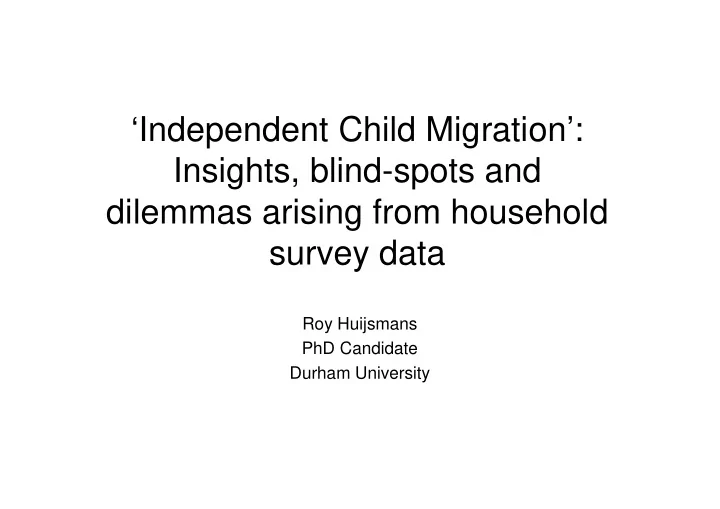

‘Independent Child Migration’: Insights, blind-spots and dilemmas arising from household survey data Roy Huijsmans PhD Candidate Durham University
Outline of presentation • Notes on context • Household survey data on ‘child migration’ – Process of analysing (category of child) – Some findings • Beyond survey data • Conclusions
Notes on Context: general • Lao PDR: – One party state; fairly new nation-state – ‘transition’ – Largely rural/agricultural – Diversity (ethnicity, religion, language, etc) • Picture: cover page of National Human Development Report (Lao PDR) 2006
Notes on Context: specific • Research Project: – Childhood; coming of age – work; incl. migrant work • Study Village: – Near Vientiane, borders with Thailand – Mainly ethnic Lao – Old settlement
Household Survey • 54 households out of 277 surveyed • Two weeks in October 2007 (rice harvest) • Sampling based on: – Administrative organisation of village – Only household with children/young people • Interviews with the head of household • Focus on: (1) general socio-ec data; (2) household composition; (3) children/young people in household
Household survey data: looking for ‘independent child migrants’ • Broad definition of ‘migration’ • How to construct the category of children, and why does this matter? – Younger than 18 years (CRC, recently adopted Lao law)? – Local understandings of ‘child’ (dek/dek noi)? – The two don’t operate in isolation
Local understanding of ‘children’ (dek/dek noi) • Refers to ‘young children’: from when a newborn can walk/crawl, till first changes in bodily appearance/behaviour • ‘dek’ are often troublesome/naughty • Disciplined by raising one’s voice, giving ‘strong’ looks • Not yet ‘shy’ • Ride bicycles • Unlikely to migrate independently for work!
(inter)national definition of ‘child’, and its frictions • Framed in biological years • underlying qualitative notions: – ‘separate from adulthood because [it is] particularly vulnerable, and thus deserving special protection, and, at the same time similar but inferior to adulthood in its capacity for agency and entitlement to autonomy, subjecthood, and voice’ (Bhabha 2006: 1528) – Childhood ‘as a time to grow, learn, play and feel safe’ with access to ‘essential services such as hospitals and schools’ and in protection of family and community (UNICEF 2005: 1) • Frictions: – Migrants in Lao context: ‘older children’ & ‘young adults’ – They are very different from ‘dek’!
Household survey data on ‘young migrants’ • Migration/mobility amongst young people is common: 40% (34/85) in corresponding group (age and social characteristics). • Both young men and women leave the village. • Yet, not randomly distributed across households (34 ‘migrants’ come from 28 households, 85 corresponding records from 41 households) – Recent settler households (considerable) – Family disruptions (some)
Purpose N (male/female) Destination 1. Agri work 8 (8m) 1 lao; 7 thai 2. Study 6 (2m;6f) 6 lao 3. ‘fostered’ 4 (2m; 2f) 4 lao 4. Factory 3 (3f) 2 lao; 1 thai 5. constr. 4 (2m;2f) 3 lao; 1 thai 6. Trade 3 (1m; 2f) 2 lao; 1 thai 7. Soldier 2 (2m) 2 lao 8. dom. Work 1 (1f) 1 thai 9. Novice 1 (1m) 1 lao 10. Unclear 2 (2f) 1 lao, 1 thai total 34 (18m;16f) 22 Lao; 12 Thai
Beyond survey data • Despite variation in reason for migration, at destination ‘work’ as a cross-cutting theme (also in fostering, religious, study) • Ambiguity of ‘family disruption’ • Issue of recent settler households (related to wider issues of ‘resettlement in Lao PDR)
Conclusions: back to biological age • Although not precisely known, it gains some relevance in study village – School, birthdays, etc • Main organising principle for government and non- governmental planners • Yet, ‘child’ thus defined carries particular connotations which set the contours for thinking & practice related to ‘children as migrants’
Recommend
More recommend